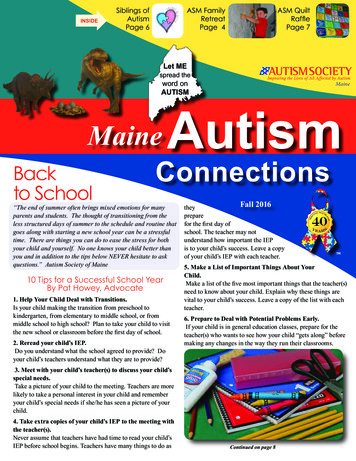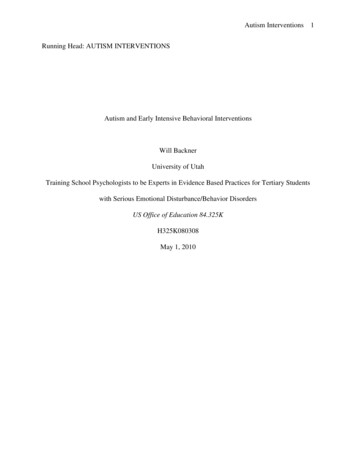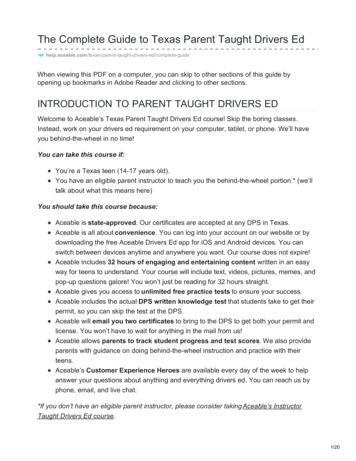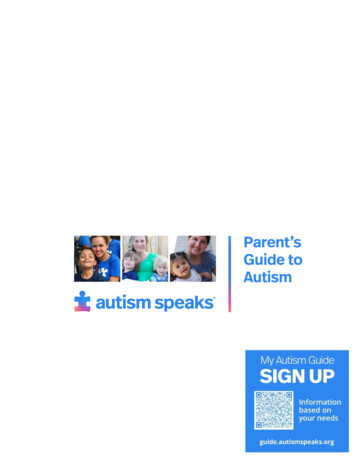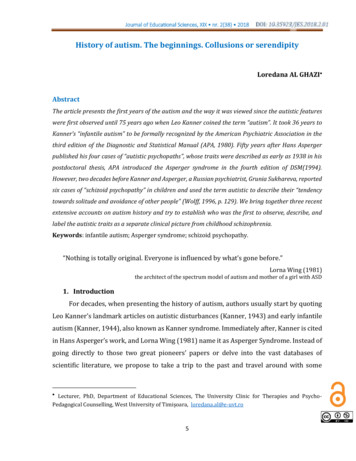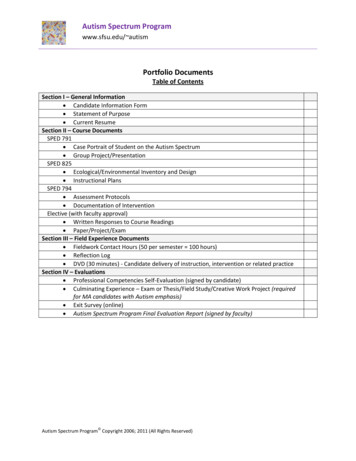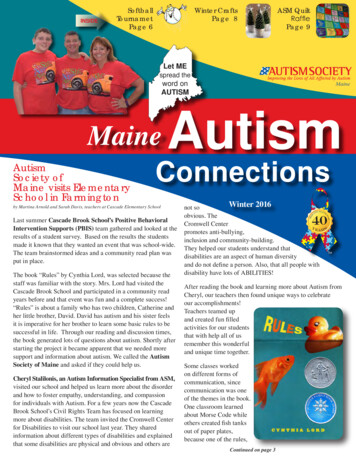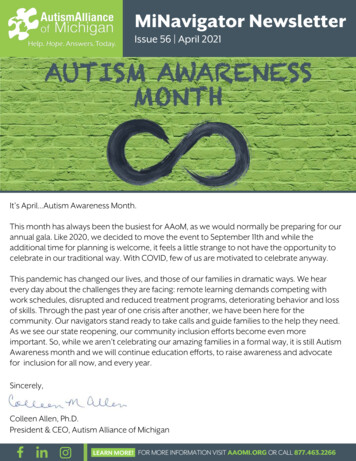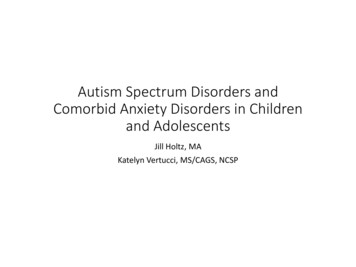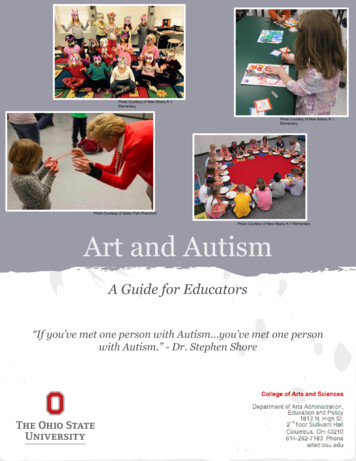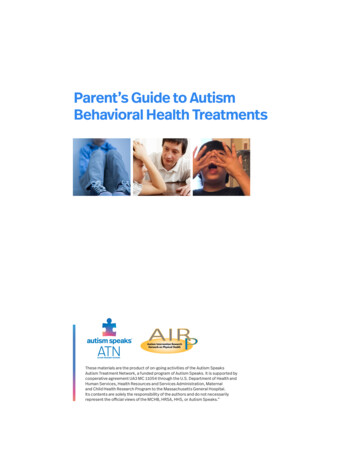
Transcription
Parent’s Guide to AutismBehavioral Health TreatmentsThese materials are the product of on-going activities of the Autism SpeaksAutism Treatment Network, a funded program of Autism Speaks. It is supported bycooperative agreement UA3 MC 11054 through the U.S. Department of Health andHuman Services, Health Resources and Services Administration, Maternaland Child Health Research Program to the Massachusetts General Hospital.Its contents are solely the responsibility of the authors and do not necessarilyrepresent the official views of the MCHB, HRSA, HHS, or Autism Speaks.”
Behavioral challenges are a common problem for children with an autism spectrumdisorder (ASD). Many children with ASD show too much of certain behaviors such asaggression or not following directions and too little of other behaviors such ascommunication or social skills.This tool kit is designed to provide parents of children with ASD with anoverview of in-home strategies as well as tips to teach and increasedesirable behaviors and decrease behavior problems. This tool kit also providesparents with an overview of professionalbehavioral treatments thatfamilies can seek out from qualified professionals. For information about moreintensive home-based treatments please refer to the ABA tool kit posted to theAutism Speaks website.TIPS FOR INCREASING APPROPRIATE BEHAVIOR AT HOMEReinforcing appropriate behavioris very important. A reinforcer is somethingyour child likes.Consider the following when providingreinforcement to your child: Reinforcers must be selected based onyour child’s likes; your child may notlike the same things other children like. Access to reinforcers should be limited.An item will lose its value as areinforcer if your child can have it anytime. Provide reinforcement immediatelyfollowing behaviors you would like toincrease. Verbal praise can be a powerfulreinforcer, provide specific verbalpraise for good behavior (e.g., Greatjob sitting nicely in your chair!).When you give a child a reinforcerimmediately after a behavior, itincreases the likelihood that thebehavior will happen again.Look for opportunities to teach and praise your child.Teach and praise appropriate communication, sharing,waiting, etc. If problem behavior happens when your childwants to get out of a particular activity, you may teach yourchild to request a break.Make requests of your child that you believe your childcan meet (Set your child up for success!). Ask your childto do things you know he/she can do independently or withminimal assistance. Additionally, break tasks and assignmentsdown into small parts and steps, or only ask your child to dopart of a task (e.g., ask him/her to pick up one block, ratherthan all the blocks).Communicate your requests clearly, in a manner yourchild understands. Also, let your child what know whathe/she will receive for doing what you asked. Increaserequests slowly as your child succeeds. Be sure to only make arequest when able to follow through on it (e.g., you have timeto wait for your child to do as you asked) and reward or praiseyour child for doing what you asked.Plan ahead to set your child up for good behavior. Findways to change the environment where problem behaviortypically takes place in order to improve your child’s behavior(e.g., keep snacks with you if your child tends to be moreaggressive when hungry).p. 2
FOCUSING ON PROBLEM BEHAVIORSTime-out is a good strategy to use for some, but not for allproblem behaviors.If the child engages in a problem behavior to avoid a task(e.g., homework), time-out may inadvertently reinforce theproblem behavior. In this case, the task the child is trying toavoid should be taken into time-out and completed there orthe child should complete the task immediately after thetime-out.On the other hand, if the child engages in a problembehavior to get attention or a favorite item, time-out mayreduce the problem behavior. When a child is in time-outhe/she should not receive attention or favorite items.Time-out tips: For time-out to be useful, "time-in" must be encouragingof appropriate behavior. When in time-in, the childshould receive frequent attention for appropriatebehavior and should have access to favorite items (e.g.,toys).When in time-out, the child should not be talked to orallowed access to any favorite items.Tips for decreasing problembehavior in your homeWork first to increase appropriatebehavior. This often also decreasesproblem behavior.Avoid providing attention during orafter problem behavior (e.g.,discussion, warnings, access topreferred items, or escape fromtasks).During problem behavior, remaincalm and remind your child of whathe/she can do, rather than whathe/she should not do (For example,“You can use your words to ask for abreak.”)After the problem behavior stops,provide immediate praise for anyappropriate behavior your childshows.Conducting a Time-OutTell your child why he/she is going into time-out in a firm yet gentle voice and takehim/her to time-out.If the child leaves the time-out area, firmly but gently guide the child back totime-out.When time-out is over, remind the child why he/she went to time-out and tellhim or her how to handle the situation with appropriate behavior in the future.Practice the new appropriate way of dealing with the situation.After time-out, time-in should immediately begin.Provide immediate reinforcement when the child demonstrates appropriatebehavior after time-out.Time-out should last about one minute for every year of mental age.p. 3
The Importance of CommunicationNot being able to appropriately request wants and/or needs is one of the most common reasons people withASD engage in problem behavior. Work with your behavioral healthcare provider to ensure your child cancommunicate in ways others can understand. This could be verbally, using sign language or through the use ofassistive communication devices.HOW PROFESSIONALS TREAT BEHAVIORAL CHALLENGESSpecialists begin by evaluating and measuring your child's skills (appropriate behaviors) and problembehaviors. These specialists gather information to determine how your child is benefiting from his orher problem behavior. By determining the purpose or function of your child’s behavior, a specialist candevelop a plan to treat the problem behavior.The function of a child’s behavior varies but often falls into one of these categories:Escaping or avoiding tasks ordemandsGetting attention from otherpeopleSeeking access to a favorite item oractivityDoing the problem behavior makesthe child feel goodSpecialists collect information on the A, B and C of your child's behaviorA is the antecedent or what happens before or with the problem behaviorB is the problem behavior you would like to changeC is the consequence or what happens after the behaviorAn example of the ABC’s of behavior:A boy with ASD is walking with his babysitter in the park when a dog begins barking loudly. The boybegins to yell. The babysitter remembers that the boy likes gum and gives him a piece. He calms down.In this example, the behavior is the boy screaming. The dog began barking before the boy beganyelling, this is the antecedent. The babysitter gave the boy gum after he began yelling, this is theconsequence.The next time the boy is at the park with the babysitter, he yells until given a piece of gum. The gum is areinforcer or something that the little boy likes that increases the frequency of the yelling behavior. Ifthe babysitter wants to stop or extinguish the yelling behavior she must stop providing the gumreinforcer following yelling behavior.p. 4
Tips to Improve the Effectiveness of Behavioral Health TreatmentsEarly identification and treatment is critical to receive the most benefit from behavioral health services. If you, yourprimary care physician or other provider has concerns regarding a delay in communication, lack or reduced social interaction,repetitive behaviors, behavioral concerns, or a general concern with developmental/cognitive delays, you may want toconsider seeking treatment.Provide detailed information to health care providers. Be specific about your child’s challenging behaviors andwhen they occur. Describe who is around, (e.g., when sharing with peers), where it happens (e.g., grocery store), and when ithappens (e.g., bath time). Your collaboration with the treatment team is critical to creating the best treatment approach.Teach others to implement the plan. Discuss with your behavioral health care provider how to teach peopleinvolved in your child’s life about the behavior plan and help them feel more confident and involved in carrying out the planto increase the plan’s effectiveness.Keep the lines of communication open. You are encouraged to give providers (e.g., pediatricians, behaviorspecialists, teachers, speech language pathologists, etc.) permission to speak with one another to coordinate care for yourchild.It is never too late to start and receive benefit from services.It is not uncommon for a child to have more difficulties during major life transitionssuch as starting elementary school, becoming an adolescent or even entering adulthood.FREQUENTLY ASKED QUESTIONS FROM FAMILIES ABOUT BEHAVIORAL HEALTH TREATMENTSQ: How will I pay for behavioral health treatments?Funding options for services may include private insurance, Medicaid, Autism Waiver, county or state developmental servicesresources, Department of Mental Health, school, scholarships, and self-pay. Additional resources such as respite services maybe available through funding agencies.Q: How long will treatment last?The length of treatment differs from child to child, some kids respond more quickly than others. It is not uncommon for somelevel of service/support to be needed throughout the child’s entire life.Q. We went to a specialist and received a treatment plan for our son’s problem behavior a week ago, but he is havingmore behavior now. What should we do?Behaviors may get worse before they get better. A two-week period is recommended for you and your son to get used to thenew routine.Review the behavior plan. Does it include strategies to decrease your son's problem behavior and increase your son’sappropriate behavior, as well as the system to improve his communication? Talk with your provider.Make sure you are carrying out the recommendations in your son’s plan exactly as they were given. Changes to the behaviorplan may make it less effective.Q: Our family has tried to carry out the behavior plan written for our daughter, but it is not working in our home. Whatshould we do?Contact your behavioral healthcare provider and discuss your concerns. Your provider may be able to make slight changes toyour daughter’s treatment plan to meet your family’s needs.p. 5
RESOURCESThe Autism Speaks Family Services Department offers resources, tool kits, and support to help manage the dayto-day challenges of living with autism www.autismspeaks.org/family-services. If you are interested in speakingwith a member of the Autism Speaks Family Services Team contact the Autism Response Team (ART) at 888AUTISM2 (288-4762), or by email at familyservices@autismspeaks.org . ART En Español al 888-772-9050Educational Information, Rights, & Policy:National Resources: NTSThis publication was developed by members of the Autism Speaks Autism Treatment Network / AutismIntervention Research Network on Physical Health-Behavioral Health Sciences Committee. Special thanks toNicole Bing, Psy.D. (Cincinnati Children’s Hospital), Brian Freedman, Ph.D. (University of Delaware), StephenKanne, Ph.D (Baylor University Medical Center), Rebecca Landa, Ph.D. (Kennedy Krieger Institute), JohannaLantz, Ph.D. (Columbia University), Donna Murray, Ph.D. (Cincinnati Children's Hospital Medical Center), LauraSrivorakiat, M.A. (Cincinnati Children’s Hospital) for their work on this publication.It was edited, designed, and produced by Autism Speaks Autism Treatment Network / Autism InterventionResearch Network on Physical Health communications department. We are grateful for review and suggestionsby many, including by families associated with the Autism Speaks Autism Treatment Network .This publicationmay be distributed as is or, at no cost, may be individualized as an electronic file for your production anddissemination, so that it includes your organization and its most frequent referrals. For revision information,please contact atn@autismspeaks.org.These materials are the product of on-going activities of the Autism Speaks Autism Treatment Network, a fundedprogram of Autism Speaks. It is supported by cooperative agreement UA3 MC 11054 through the U.S.Department of Health and Human Services, Health Resources and Services Administration, Maternal and ChildHealth Research Program to the Massachusetts General Hospital. Its contents are solely the responsibility of theauthors and do not necessarily represent the official views of the MCHB, HRSA, HHS. Images for this tool kit werepurchased from istockphoto . Written March 2012.p. 6
Autism Treatment Network, a funded program of Autism Speaks. It is supported by . Behavioral challenges are a common problem for children with an autism spectrum disorder (ASD). Many children with ASD show too much of certain behaviors such as . intensive home-based treatments please refer to the ABA tool kit posted to the Autism Speaks .
